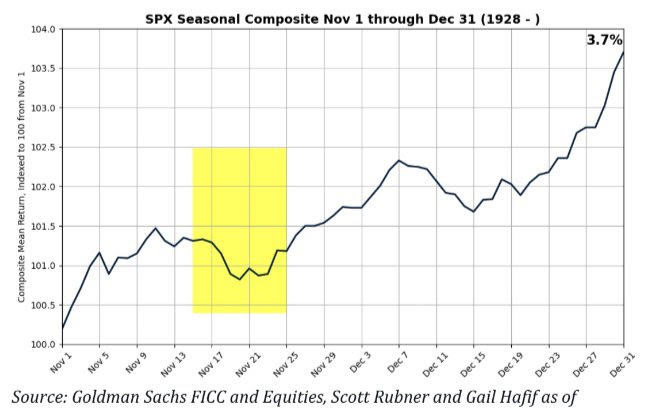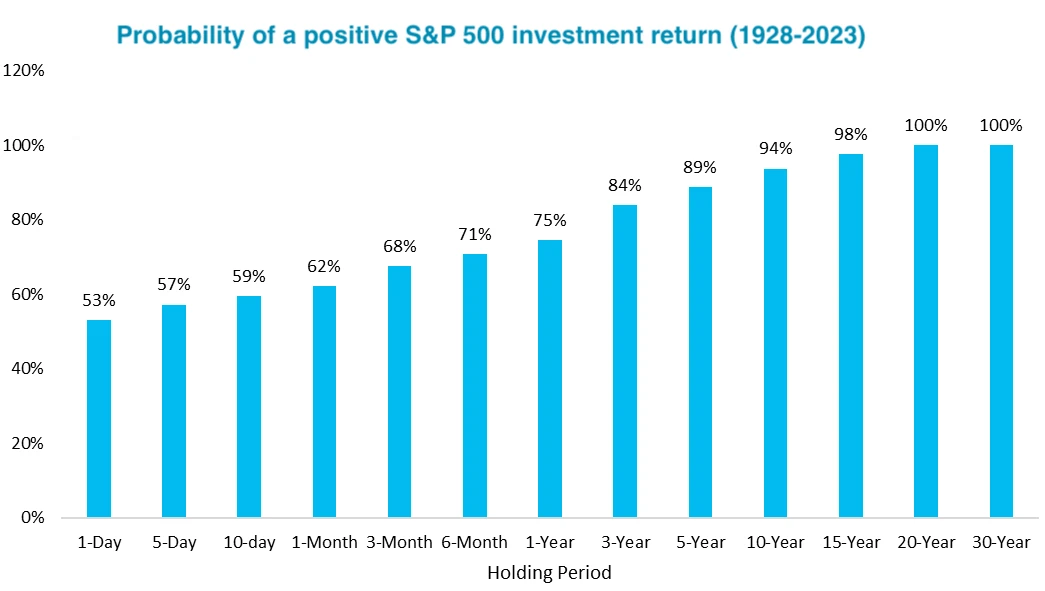The Santa Claus Rally refers to a historically observed stock market phenomenon where U.S. equity markets tend to perform well during the last five trading days of the year and the first two trading days of the new year. Historically, the average gain during this seven-day period is around 1.3%.
As time has gone on, largely thanks to bullish optimism, the Santa Claus Rally has extended in both duration and upside. Today, the Santa Claus Rally rally begins as early as November 25 and lasts through the end of the year. During this modern-day version of the Santa Claus Rally, the average S&P 500 return is double at 2.6%.

Origins of the Santa Claus Rally
The term was popularized by Yale Hirsch, the creator of the Stock Trader’s Almanac, in the 1970s. Hirsch observed this recurring pattern of market strength during the holiday season and dubbed it the “Santa Claus Rally.”
While the exact origins are not tied to any single event, the phenomenon has been recognized for decades and studied extensively in financial markets.
Historical Trends Of The Santa Claus Rally
- Timing: The rally typically spans the final five trading days of the calendar year and the first two trading days of the new year.
- Performance: Historically, the S&P 500 has shown average gains of about 1.3% during this seven-day period, which is notably higher than the average weekly performance throughout the year.
- Frequency: Over 70% of the time, the markets have posted positive returns during this period. It’s similar to how in any given year, the S&P 500 closes up 70% of the time for the year.

Theories Behind the Santa Claus Rally
Several theories attempt to explain why the Santa Claus Rally occurs:
- Optimism and Holiday Cheer: The holiday season often fosters a sense of optimism among investors, leading to increased buying activity. As humans, most of us are hardwired to expect better times ahead for our own survival.
- Tax Considerations: Some investors sell losing positions before year-end to harvest tax losses, followed by reinvestments in the market. However, this selling needs to occur before November, usually in October, for the Santa Claus Rally to have a greater chance of occurring. Tax-loss harvesting may be one reason why October tends to be one of the weakest trading months of the year.
- Low Trading Volume: With many institutional investors and traders on holiday, retail investors may exert greater influence on the market, often skewing it upward.
- Year-End Bonuses: The influx of year-end bonuses can lead to increased investment activity.
- Portfolio Rebalancing: Fund managers may adjust portfolios to improve year-end performance metrics, adding to market gains.
- New Year Expectations: Investors position themselves for a strong start to the new year, contributing to the rally.
Wall Street Is Almost Always Optimistic In The Fourth Quarter
When I was working on Wall Street at Goldman Sachs and Credit Suisse, the talk of the Santa Claus Rally would begin in mid-November. As the year wound down, the atmosphere turned festive, and anticipation for year-end bonuses grew. These bonuses often ranged from 20% to 250% of our base salaries, creating a palpable buzz throughout the office.
November through February was arguably the best time to be an investment banker or Wall Street trader. The pace of work slowed, holiday parties were in full swing, and the hefty bonus checks made it all the more rewarding. It was a time to celebrate the year’s hard work and enjoy the fruits of our labor.
Once the bonus checks hit by the end of February, hungry workers would often jump to a competing firm for a higher guaranteed pay day. I somewhat regret not taking the money by jumping ship as well. I was a loyal solider at Credit Suisse for 11 years, shunning an opportunity in New York City at an upstart bank that offered me a two-year guarantee for much more money.
For those of you with full-time jobs, cherish the fourth quarter! Once you retire, you’ll miss the luxury of getting paid full wages for taking it easy. It’s like being on parental leave while still earning your full salary. Oh, how I wish I had enjoyed those benefits back when I was working!
The Significance of the Santa Claus Rally
The Santa Claus Rally is often seen as a barometer of short-term market sentiment. When the rally fails to materialize, it can signal bearish sentiment or broader economic concerns for the year ahead. Investors, often influenced by superstition, tend to act on momentum—whether positive or negative.
Negative momentum in the stock market frequently persists until a significant catalyst shifts sentiment. Similarly, positive momentum can sustain itself, especially when uncertainty about the future diminishes, creating a feedback loop that drives further gains.
For example, markets sometimes rally after a new president gets elected, building on existing momentum and sparking a year-end Santa Claus Rally.
The S&P 500 has generally performed well under the Biden/Harris administration, except for the bear market in 2022. Looking ahead, with Donald Trump’s return to office, there’s optimism tied to his policies favoring lower taxes and reduced regulation—both of which can boost corporate earnings and stock prices.
If Harris had won, stock market momentum would likely have continued, as her victory would have removed uncertainty about the next four years. Her policies would likely have been similar to Biden’s, potentially with a more moderate approach.
Invest For The Long Term
While the Santa Claus Rally has generally held up over time, its predictive power is far from certain, especially in volatile markets. Events like geopolitical tensions, unexpected economic data, or Federal Reserve policy shifts can easily overshadow this seasonal trend. Still, some short-term traders might be tempted to capitalize on the rally, looking to day trade during this time period.
The Santa Claus Rally remains a fascinating and much-discussed phenomenon, underscoring the psychological and behavioral patterns that influence market movements. It serves as a reminder of how tradition and sentiment can drive investor behavior, even in sophisticated financial markets.
That said, getting too emotional in either direction is rarely beneficial for investors. The best approach is to stay disciplined—dollar-cost averaging into the market with your available cash flow and maintaining a long-term investment perspective. Over time, consistency tends to beat chasing seasonal trends.
Readers, what do you think about the chances of a Santa Claus Rally this year, given the strong performance of the S&P 500 so far? Do you engage in any extra trading or year-end rebalancing that might contribute to market momentum?
Diversify Into Private Real Estate
With stocks performing so strongly, you may want to diversify into real estate. It is an investment that combines the income stability of bonds with greater upside potential. The Fed is on a multi-year interest rate cut cycle, and I expect real estate demand to grow in the coming years.
Consider Fundrise, a platform that allows you to 100% passively invest in residential and industrial real estate. With over $3 billion in private real estate assets under management, Fundrise focuses on properties in the Sunbelt region, where valuations are lower, and yields tend to be higher.
I’ve personally invested over $270,000 with Fundrise, and they’ve been a trusted partner and long-time sponsor of Financial Samurai. With a $10 investment minimum, diversifying your portfolio has never been easier.
Join 60,000+ others and subscribe to my free weekly newsletter here. Financial Samurai was founded in 2009 and is the leading personal finance website today. Everything is written based on firsthand experience as money is too important to be left up to pontification.
